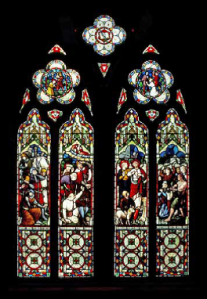High above the baptistry is the great West Window, which is dedicated to two soldiers who died in the New Zealand Wars (which is discussed in this post).
The window itself, however, had been planned for some time before their deaths. Lavers and Barraud, the London stained glass window firm which made most of the windows in St Paul’s, was established by Francis Barraud; his brother Charles Decimus Barraud had emigrated to Wellington and was an artist, pharmacist, and a long-term St Paul’s congregation member. The firm’s planned image for the window had been on display in Charles’ chemist shop window in Wellington since March 1867, as a way of trying to raise money for it. But the money was slow coming in, until the idea of using the glass as a memorial to the soldiers arose.
The window itself depicts the life, appropriately enough, of St Paul. I think I am right in saying that this window, and one wooden carving on the pulpit, are the only representations of St Paul in the church. The two windows on the left shows Paul’s moment of conversion to Christianity on the road to Damascus, and the two on his right show scenes from travels preaching the gospel with St Barnabas, when he was in Lystra, in what is now Turkey. While there he healed a man, and he and Barnabas were mistaken for the gods Hermes and Zeus, so tore their clothes, to show they they were only men.
The window was installed in 1870. The Wellington Independent, who had employed as a journalist one of the two men to whom the window is dedicated, wrote ‘we think the window a most beautiful and appropriate memorial to memory of those two gallant spirits who were loved so well, and is creditable to the hearts and taste of the Veterans of the Province’.
The large window in the centre is the West Window from the outside.
Source: New Zealand Advertiser, 15 March 1867, p.5; Wellington Independent, 28 June 1870, p.2


